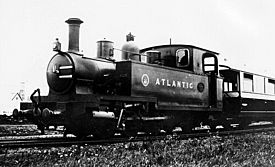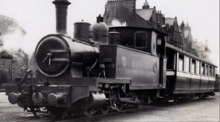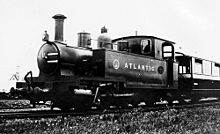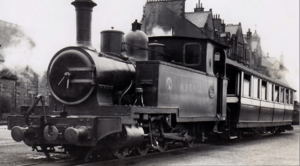Campbeltown and Machrihanish Light Railway facts for kids

'Atlantic', the last locomotive built for the Campbeltown and Machrihanish Light Railway, Andrew Barclay 0-6-2T, builder's photograph, 1907
|
|
| Overview | |
|---|---|
| Headquarters | Campbeltown |
| Locale | Scotland |
| Dates of operation | 1876–1932 |
| Successor | abandoned |
| Technical | |
| Track gauge | 2 ft 3 in (686 mm) |
The Campbeltown and Machrihanish Light Railway was a special narrow-gauge railway in Kintyre, Scotland. It connected the town of Campbeltown with the coalmining village of Machrihanish. This railway was quite unique because it used a very narrow track, only 2 ft 3 in (686 mm) wide. In the whole of the UK, only three other passenger railways used this same narrow track, and all of them were in Wales!
Contents
Why Was the Railway Built?
Coal has been dug up in the Kintyre area for a very long time, even before 1498. This coal wasn't the best quality, but there was a lot of it, and it was easy to get out of the ground. In the 1700s, the local coal mines were busy supplying coal to the many whisky factories in Campbeltown.
Early Transport: The Canal
In 1773, a famous engineer named James Watt (who improved the steam engine!) looked at building a canal. The idea was to connect the coal mines to Campbeltown so it would be cheaper to move the coal. The 3-mile (4.8 km) Campbeltown and Machrihanish Canal opened in 1791.
However, this canal wasn't used much and was almost completely abandoned by 1856. In 1875, a company called Argyll Coal and Canal Co. bought the main coal mine. They found the canal in bad shape and decided they needed a much better way to transport coal. That's when they started thinking about building a railway to Campbeltown.
The First Railway: For Coal Only
As railways became more popular in the 1800s, the coal mine owners decided to build a simple railway instead of fixing the old canal. In 1876, a lightly built industrial railway was created. It connected the Kilkivan coal pit to Campbeltown, a distance of about 4+1⁄2 miles (7.24 km). For a short part of its journey, the railway even ran where the old canal used to be! It ended at a pier in Campbeltown.
This first railway only carried coal. It used two locomotives (steam engines) named Princess and Chevalier to pull wagons full of coal.
The Light Railway: For People and Coal
The coal railway mostly carried coal during certain times of the year. Around 1900, the mine owners wanted to find more things for the railway to carry, especially in the summer. At the same time, new steam ships started bringing tourists to the beautiful Kintyre area. This gave them an idea! They formed a new company to build a railway connecting Campbeltown with Machrihanish, which is on the west coast of the peninsula.
Building the Campbeltown and Machrihanish Light Railway began in November 1905. Most of the new railway followed the path of the old coal railway, but they made some changes. They made the steep hills less steep and the sharp turns less sharp. They also extended the line west to a new station in Machrihanish. The work was finished in 1906, and the railway opened on August 18, 1906. It was a huge hit! In its first three weeks, 10,000 passengers rode the train. It quickly replaced the old horse-drawn carts that used to take tourists around Campbeltown.
Before World War I, the railway did very well, carrying both coal and passengers. After the war, new motor buses started to appear, which meant fewer tourists chose to ride the train. By 1931, the summer tourist business had shrunk a lot. Passenger trains still ran in early 1932, but the railway was struggling. It stopped carrying passengers in May 1932. By November 1933, the railway company had closed down. In May 1934, the very last trains ran, helping to take apart the railway tracks themselves.
A Company's Attempt to Make Oil
Around 1929, a company called Maisel Oil Company bought the railway and the coal mine. This company had a special way to try and make oil from coal. However, this idea didn't work out well. Because of this, the railway stopped carrying passengers in September 1931 and closed completely in November 1932.
What Trains Did They Use?
Locomotives (Engines)
The railway used several different steam engines over its lifetime. Here are some of them:
| Name | Photograph | Builder | Wheel arrangement (Whyte notation) |
Built | Notes |
|---|---|---|---|---|---|
| Pioneer | Andrew Barclay & Sons Co. | 0-4-0WT (later 0-4-2WT) |
1876 | This engine was for the first coal railway. It never ran on the Campbeltown and Machrihanish Light Railway. | |
| Chevalier | Andrew Barclay & Co | 0-4-0ST (later 0-4-2ST) |
1885 | This engine was rebuilt in 1926 using parts from the Princess engine. | |
| Princess | Kerr, Stuart & Co. | 0-4-2T | 1900 | This engine was taken apart before 1931. | |
| Argyll |  |
Andrew Barclay & Sons Co. | 0-6-2T | 1906 | |
| Atlantic |  |
Andrew Barclay & Sons Co. | 0-6-2T | 1907 | This engine looked exactly like Argyll. |
Passenger Carriages
In 1906, a company called R.Y. Pickering & Co. built four passenger carriages for the railway. Each carriage had a main seating area with wooden seats, like old tram cars, and could hold 64 passengers. They also had open platforms at each end. Two more carriages were added in 1907, one of which had a special area for luggage.
These carriages were still around after the railway closed. In 1934, they were moved to Trench Point, across Campbeltown Loch, and used as holiday homes! During World War II, the navy used them. After the war, they were left to fall apart, and their frames were finally scrapped in 1958.
Interestingly, there are six passenger coaches on the 15 in (381 mm) gauge Ravenglass & Eskdale Railway in England that look like the Campbeltown carriages. They were built in 1989 and 1990.
Freight Wagons
Wagons for the Coal Railway
The first coal railway probably used small mine tubs that came directly from the mines. By 1902, they had 18 flat wagons, each carrying four "mine hutches." These hutches were small tubs, and each one carried about 9+1⁄2 long hundredweight (480 kg) of coal. The hutches were placed sideways on short rails on the main railway wagons.
Wagons for the Light Railway
When the railway was rebuilt in 1906, they got new, more standard wagons. They bought many 3+1⁄4-long-ton (3.6-short-ton; 3.3 t) four-wheel open-sided coal wagons. These wagons had simple buffers and a coupling in the middle. Later, they bought even bigger wagons that could carry 4+1⁄2-long-ton (5.0-short-ton; 4.6 t). In total, the railway used about 150 coal wagons, all owned by the Campbeltown Coal Co.
Besides the coal wagons, the railway also had a few other wagons for different goods. They had a 7-long-ton (7.8-short-ton; 7.1 t) brake van (a special wagon for the guard). They also had an open-sided milk wagon, designed to carry milk churns. Finally, the railway had a snow plough that could be attached to an engine and a small trolley for workers to use for track maintenance.
Where Were the Stations?
None of the stations on the Campbeltown and Machrihanish Light Railway had raised platforms. However, there was a small wooden shed with a metal roof at Machrihanish. The stations and stops along the line were:
- Campbeltown
- Plantation Halt
- Moss Road Halt
- Lintmill Halt
- Colliery Road
- Drumlemble Halt
- Machrihanish Farm Halt
- Trodigal Halt
- Machrihanish
See also
- List of 2 ft 3 in gauge railways
- British narrow gauge railways
Images for kids




